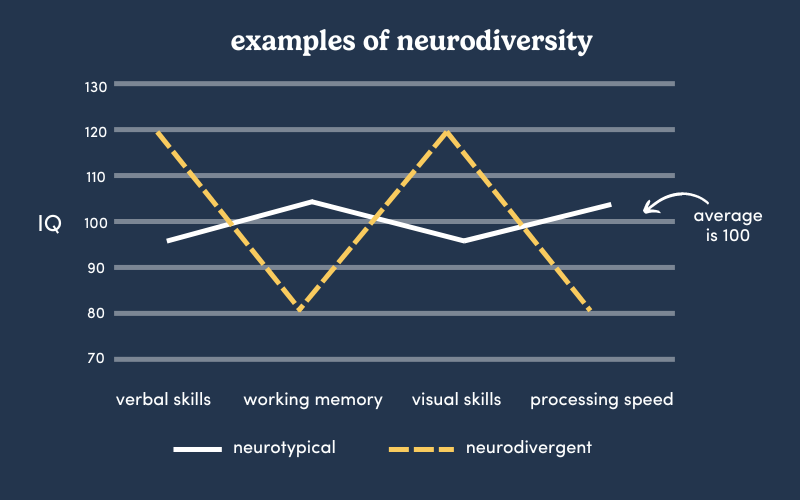Neurodiversity: Everything you should know
Updated: March 23, 2024 · 8 Minute Read

Reviewed by:
Amy Gong, Neurodiversity Advocate
Highlights
- Neurodiversity is the idea that our brains and minds naturally perceive, process, and present information in different ways.
- The term is often used to describe neurodevelopmental differences such as ADHD, autism, and dyslexia.
- Neurodiversity challenges us to consider the unique ways of processing our world not as problems to be cured, but rather natural variations in brain function.
- Mainstream acceptance of neurodiversity has important implications for educating, working with, and supporting neurodivergent people.
What is neurodiversity?
Neurodiversity is the idea that we all have different kinds of minds. We think, learn, behave, and experience the world in a variety of ways. The neurodiversity movement challenges us to reconsider how we think about these unique ways of processing our world.
Our neurological differences are not problems to be cured, but rather natural variations in brain function. A great analogy: a Mac computer doesn’t run on Windows, but that doesn’t mean it’s broken, it’s just different.
Terms to know:
- Neurodiversity: noun, The idea that our brains and minds naturally perceive, process, and present information in different ways. The idea asserts that neurological differences are a valuable part of human diversity. Example: They believe that autism is a form of neurodiversity and that many of the difficulties autistic people face are due to society rather than the condition itself.
- Neurotypical: adjective, This describes individuals with the most common and ‘typical’ brain type. Example: Blake developed how most kids typically do. He is neurotypical.
- Neurodivergent: adjective, A person whose brain and mind vary from the most common brain type. Example: Sam has neurodivergent traits. She is neurodivergent.
- Neurodiverse: adjective, This describes a group that includes both neurotypical and neurodivergent individuals. Example: My ADHD brother is neurodivergent. My mom is neurotypical. We are a neurodiverse family.
Examples of neurodiversity
Neurodiversity is an intentionally broad (and inclusive) term. The term is often used to describe neurodevelopmental differences such as ADHD, autism, and dyslexia. Each neurodivergent person is unique in their own way, however, there are commonalities.
Neurodivergents commonly report these strengths and challenges:
Common neurodivergent strengths:
- Inventive or “bottoms up” thinking
- Pattern recognition
- Strong work ethic
- Spatial awareness
- Strong memory
- Attention to detail
- Strong focus
- Creativity
Common neurodivergent challenges:
- Sensory processing
- Changes in routine
- Social communication
- Distractibility and impulsivity
- Reading and spelling
- Coordination of movement
- Working memory
It is important to note that neurodiversity is not related to intelligence. While neurodivergent people may struggle with classrooms and workplaces designed for “typical” people, they are not any more or less intelligent.

Source: Doyle, 2020
Neurodivergent people have and continue to play a very important role in our society, such as the prominent figures below.
Prominent neurodivergent people
- Albert Einstein – One of the greatest thinkers of the 20th century. Struggled with delayed speech and grammar. Autistic.
- Bill Gates – Founder of Microsoft and world’s richest man. Dyslexic.
- Jennifer Aniston – Emmy award winning actress and producer. Dyslexic.
- Greta Thurnberg - Climate and environmental activist. Autistic.
- Temple Grandin - World-renowned animal scientist, author, and speaker. Autistic.
- Richard Branson – One of the most influential businessmen in the world. Dyslexia and ADHD.
- Susan Boyle – Grammy nominated singer, sold over 19M albums worldwide. Autistic.
- Elon Musk – Entrepreneur and investor. Autistic.
- Anthony Hopkins - Actor, director, and producer. Autistic.
- Daryl Hannah - American actress and environmental activist. Autistic.
A brief history of neurodiversity
The concept of neurodiversity is relatively new. Australian sociologist Judy Singer coined the term in the 1990s. She created the term to catalyze the inclusion of neurological minorities. Singer’s leadership is captured best by autistic advocate Marcie Ciampi, “In the 1990’s, Singer recognized that people with different kinds of minds were oppressed in the same ways women and gay people were, before they had their own movement, and that the neurologically diverse needed a movement of their own.”7
Singer popularized the term along with the help of American journalist Harvey Blume, who wrote about neurodiversity in The Atlantic that same year.8 Blume writes, “Neurodiversity may be every bit as crucial for the human race as biodiversity is for life in general. Who can say what form of wiring will prove best at any given moment?”
The neurodiversity movement has been impactful and it’s not slowing down. Neurodiversity is a growing civil rights movement that challenges social norms. It seeks to reorient how we think about brain-based differences from how do we fix the individuals to how do we include the individuals as they are. We continue to follow the community’s lead and listen to neurodivergent voices as we work to improve everyday experiences.
The relationship between neurodiversity and disability
Neurodiversity and disability are both important terms that co-exist but are not equal. It is a common misconception that the neurodiversity movement romanticizes debilitating conditions that require a lot of support. This is not true.
Neurodivergents, like all people, require different levels and types of support to achieve their goals. Some neurodivergent people are independent, while others have high support needs. Few neurodiversity advocates deny the need for accommodations or the existence of impairments. And the community supports solutions for health challenges that often can accompany neurodiversity, such as epilepsy.9
Each neurodivergent individual has their own preferences in terms of how they think about themselves. Some might consider their differences a disorder, condition, disability, or way of being. It is important to always ask a person what they prefer.
A disability helps people get access to medical services. Neurodiversity isn’t a medically recognized term (yet). Being diagnosed with a disability gives people important protections under the law to access the support they need at school and work, such as early intervention services. Early access to these support services has proven to meaningfully improve quality of life for neurodivergent individuals in the long-term.10 You can find neurodiversity-friendly providers who take your insurance in our directory.
Why is neurodiversity important
There’s a big chance you or someone you love is neurodivergent. 15-20% of the global population is considered neurodivergent.11 We all will encounter neurodiversity in our lives, in our schools, jobs, or homes.
We are facing a talent shortage, and yet the neurodivergent unemployment rate is as high as 30-40%, 10x times that of the general population. What’s worse, studies show the risk of suicide is also 10x of the general population.12 It is imperative we create a more inclusive world for the benefit of neurodivergent individuals, but also society at large.
Individuals benefit. Understanding neurodiversity supports self-awareness and belonging. On the individual level, identifying as neurodivergent can help people better understand themselves. This has tremendous implications for well-being and self-worth. Once someone knows they are neurodivergent, it puts their life in context. They can better understand their strengths and challenges, and find community amongst others with similarly unique experiences.
The world benefits. Like other types of diversity, there is strength in our differences. Divergent thinking, thinking differently, can lead to new ideas and creative problem-solving. Harvard Business Review and many others talk about “neurodiversity as a competitive advantage” in the workplace.11 We are doing individuals and our society a disservice by not not acknowledging and embracing neurodiversity. Failing to support these highly valuable employees means we are all losing.
Get our best articles delivered to your inbox each month.
We respect your privacy.
Article References
- Resnick, CNC A, Lakhan, MD, PhD, FAAN S. What Is Neurodiversity? Verywell Mind. Published February 7, 2022. https://www.verywellmind.com/what-is-neurodiversity-5193463
- Nall R. Why Having ADHD Can Be a Benefit. Healthline. Published January 19, 2021. https://www.healthline.com/health/adhd/benefits-of-adhd#personality-strengths
- Russell G, Kapp SK, Elliott D, Elphick C, Gwernan-Jones R, Owens C. Mapping the Autistic Advantage from the Accounts of Adults Diagnosed with Autism: A Qualitative Study. Autism in Adulthood. 2019;1(2):124-133. doi:10.1089/aut.2018.0035
- Ciampi M. Bottoms-Up: The Innovative Thinking Style of the Asperger’s Mind. DIFFERENT BRAINS. Published April 23, 2017. Accessed April 19, 2022. https://www.differentbrains.org/bottoms-up-the-innovative-thinking-style-of-the-aspergers-mind/
- Armstrong T. The myth of the normal brain: embracing neurodiversity. AMA Journal of Ethics. 2015;17(4):348-352. doi:10.1001/journalofethics.2015.17.4.msoc1-1504
- Doyle N. academic.oup.com. Published September 30, 2020. Accessed April 14, 2022. https://academic.oup.com/bmb/article/135/1/108/5913187?login=false
- Meet Judy Singer Neurodiversity Pioneer - My Spectrum Suite. My Spectrum Suite. Published 2019. http://www.myspectrumsuite.com/meet-judy-singer/
- Blume H. On the neurological underpinnings of geekdom. The Atlantic. Published September 30, 1998. https://www.theatlantic.com/magazine/archive/1998/09/neurodiversity/305909/
- Bailin, Aiyana. “Clearing up Some Misconceptions about Neurodiversity.” Scientific American Blog Network, Scientific American, 6 June 2019, https://blogs.scientificamerican.com/observations/clearing-up-some-misconceptions-about-neurodiversity/
- Landa, R.J. Efficacy of early interventions for infants and young children with, and at risk for, autism spectrum disorders, International review of psychiatry (Abingdon, England). U.S. National Library of Medicine. Available at: https://www.ncbi.nlm.nih.gov/pmc/articles/PMC6034700/
- Ott DL, Russo E, Moeller M. Neurodiversity can be a workplace strength, if we make room for it. The Conversation. Published September 24, 2020. https://theconversation.com/neurodiversity-can-be-a-workplace-strength-if-we-make-room-for-it-164859
- MyDisabilityJobs Neurodiversity in the workplace: Statistics: Update 2022, MyDisabilityJobs.com. Available at: https://mydisabilityjobs.com/statistics/neurodiversity-in-the-workplace/
- Hirvikoski T, Mittendorfer-Rutz E, Boman M, Larsson H, Lichtenstein P, Bölte S. Premature mortality in autism spectrum disorder. British Journal of Psychiatry. 2016;208(3):232-238. doi:10.1192/bjp.bp.114.160192













